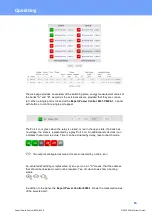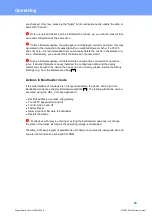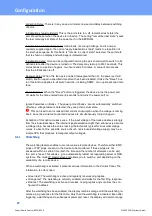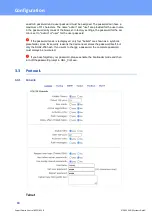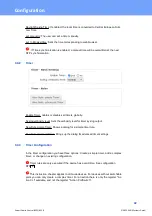
27
Expert Power Control 8221/8226
© 2022 GUDE Systems GmbH
Configuration
tialization Delay. There is in any case a minimum one-second delay between switching
of ports.
Initialization status(coldstart): This is the port state (on, off, remember last state) the
port should be set when the device is turned on. The setting "remember last state" saves
the last manually set state of the power port in the EEPROM.
Initialization status(bank repower): Had a bank not enough voltage, and is now ad-
equately supplied again, the option "apply initialization status" leads to a repetition of
the start-up sequence for this bank. Is "remain in current state" selected, the port state
that is shown on display and web page is implemented.
Initialization delay: Here can be configured how long the port should wait to switch to its
defined state after the device is turned on. The delay may last up to 8191 seconds. This
corresponds to a period of approx. two hours and 20 minutes. A value of zero means
that the initialization is off.
Repower delay: When this feature is enabled (value greater than 0), the power port will
switch itself on again a specified time after it has been disabled. Unlike the "
Reset
" but-
ton this function applies to all switch actions, including SNMP, or an optional serial inter-
face.
Reset Duration: When the "
Reset
" button is triggered, the device turns the power port
off, waits for the time entered here (in seconds) and turns the power port on.
Ignore Powerloss on Bank x: The power ports of bank x are not automatically switched
off when a voltage failure is detected, they keep their actual state.
This can lead to an increased total current consumption when the voltage is coming
back, since the activated connected devices are simultaneously turned on again.
Activation of this option makes sense, if the input voltage of the device deviates strongly
from the sinusoidal shape. The internal signal evaluation might then erroneously assume
a voltage drop, because the zero-crossing characteristic typical for sinusoidal voltage
curves is absent. One possible source of such non-sinusoidal voltage supply may be a
simple UPS that produces rectangular output voltages.
3.1.1
Watchdog
The watchdog feature enables to monitor various remote devices. Therefore either ICMP
pings or TCP pings are sent to the device to be monitored. If these pings are not
answered within a certain time (both the time and the number of attempts can be set),
the port is reset. This allows e.g. to automatically restart not responding server or NAS
systems. The mode IP master-slave port allows you to switch a port depending on the
availability of a remote device.
When a watchdog is activated it presents various information in the Control Panel. The
information is color-coded.
·
Green text: The watchdog is active and regularly receives ping replies.
·
Orange text: The watchdog is currently enabled, and waits for the first Ping response.
·
Red text: The watchdog is active and receives no ping replies anymore from the con-
figured IP address.
After the watchdog has been enabled, the display remains orange until the watchdog re-
ceives a ping response for the first time. Only then the watchdog is activated. Even after
triggering a watchdog and a subsequent power port reset, the display will remain orange
Summary of Contents for Expert Power Control 8221 Series
Page 2: ...2 Expert Power Control 8221 8226 2022 GUDESystems GmbH ...
Page 5: ...Device Description ...
Page 14: ...Operating ...
Page 25: ...Configuration ...
Page 54: ...Specifications ...
Page 109: ...Support ...




